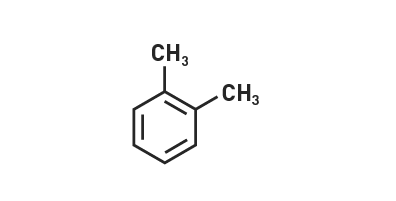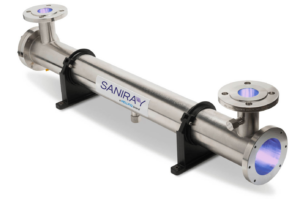VOC removal
Effective VOC removal with our advanced solutions
The term VOC (Volatile Organic Compounds) refers to a broad range of various chemical compounds. All VOC are organic chemicals (i.e. containing carbon) with a high vapor pressure at ordinary room temperature. This group of compounds is divided in categories such as aromatics, aldehydes or hydrocarbons. Each category has different chemical properties, possibly leading to various environmental issues.
Emission sources
The VOC are emitted by various sources throughout the European region. The most common ones are the “industrial processes” and the “commercial, institutional and household fuel consumption”. Only those two sources combined emit two thirds of the total European emission, so they will be the focus of this page.
VOC emission sources

Figure 1. VOC emission sources in the EU-28 area. Source: “Air quality in Europe – 2017 report” EEA Report No 13/2017.
Environmental problems
The emission of VOC in the atmosphere causes environmental issues. Some VOC may cause odor problems due to their high odor intensity. Such cases are often encountered in food processing industries (external site) and wastewater treatment plants. Toxicity is another issue related with VOC. Even if the use of the most toxic compounds has been strictly limited, the emissions of high concentrations may contribute to a toxic environment. For this reason, regulations are in place to reduce this hazard. A typical example is the solvent emission from industries such as the pharmaceutical, textile (external site) paint and coating.
VOC in industrial and commercial applications
 Acetaldehyde (aldehydes)
Acetaldehyde (aldehydes)
Acetaldehyde belongs to the category of aldehydes. It is naturally found in coffee, bread, and ripe fruit.
Acetaldehyde is one of the most important air pollutants because it is toxic, irritating and carcinogenic. Acetaldehyde emissions may also cause odor problems, especially from commercial kitchens and food processing industries (external site)
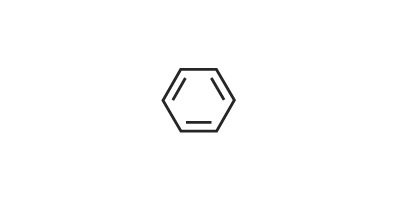 Benzene (aromatics)
Benzene (aromatics)
Benzene is one of the most famous aromatic compounds. It has been widely used as solvent and it currently is an important intermediate in the chemical industry.
Due to being a known carcinogen, the use of benzene as a solvent has been widely replaced. The industrial emissions from industries such as petrochemical and chemical production need to be carefully monitored.
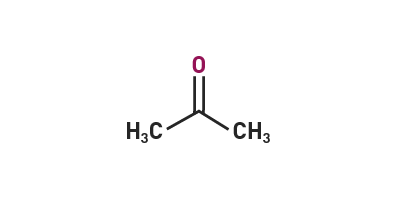 Acetone (ketones)
Acetone (ketones)
Acetone belongs to the category of ketones. It is widely used as solvent in many industrial processes.
Even if acetone does not have a high toxicity, emissions with high concentration are strictly regulated. Acetone may be found in industries such as pharmaceutical, textile (external site) and paint industries.
 Skatole (aromatics)
Skatole (aromatics)
Skatole is affiliated to the category of aromatic. It is naturally produced in the digestion of proteins. In low concentrations, it is used as fragrance.
While pleasant at low concentrations, skatole is malodorous at higher concentrations. It is often related to odor problems in wastewater treatment plants.
Xylenes (aromatics)
Xylenes belong to the category of aromatics. They are important chemical intermediates used production of plastic PET bottles.
Air emission of xylenes is often associated with odor problems, due to the low odor threshold. They are also toxic if emitted at high concentrations. Xylenes are emitted by biogas production plants any chemical industries.
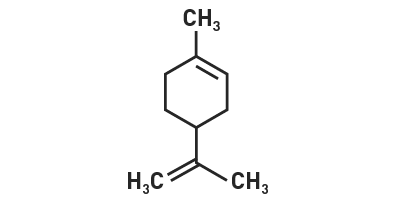
Limonene (terpenes)
Limonene is one of the most common terpenes. It is the major component in oil of citrus fruit peels, so it takes its name from the word “Lemon”.
Emissions of limonene are related to odor problems, due to the low odor threshold and high concentration in many types of plants. Limonene is emitted from food processing and biogas industries (external sites).
We are specialists in analyzing the type and concentration of VOC in your case. Read more about air and odor analysis .
Directives and regulations on VOC emission
Due to the environmental issues caused by VOC, several directives and regulations has been enforced, both at the European and national level. Considering the European directives, two important milestones were set by the 2001/81/EC and the 2016/2284. The first directive sets national emissions ceilings for the VOC emission from all sources to be reached by the year 2010. The second directive specifies the percentage reduction for the VOC emissions, both for the single countries and for the whole EU-area. Since the 2001, the EU has been very active for reducing the VOC emissions, setting high reduction goals as shown in the Figure below.

Planned VOC emissions reduction according to the Directive 2016/2284 for the EU-28 area and for Sweden. The percentage reduction is calculated based on the emissions for the year 2005. Two milestones are set: the year 2020 and 2030.
The 2016/2284 EU directive was transposed in Sweden by the Swedish parliament with the regulation SFS 2017:418.
VOC removal for specific industries
Besides the directives regarding the overall VOC reduction, specific actions were taken to limit the emissions from certain industries and sectors. One example is the directive 2010/75/EU regulating combustion plants, incineration plants, production of titanium dioxide and use of organic solvents. For this last sector, many limits for the emission concentrations in waste gases were defined, according to the type and size of industry using solvents. Most of these limits vary between 20 and 100 mg C/Nm3. As for all the EU directives, the 2010/75/EU was transposed in Sweden with the regulations SFS 2013:254 and SFS 2014:20.
Ozone and AOP for VOC removal
No matter the purpose of the air treatment, we offer many solutions for removing VOC from many industries. An example of VOC reduction using Ozonetech’s technologies is presented below.
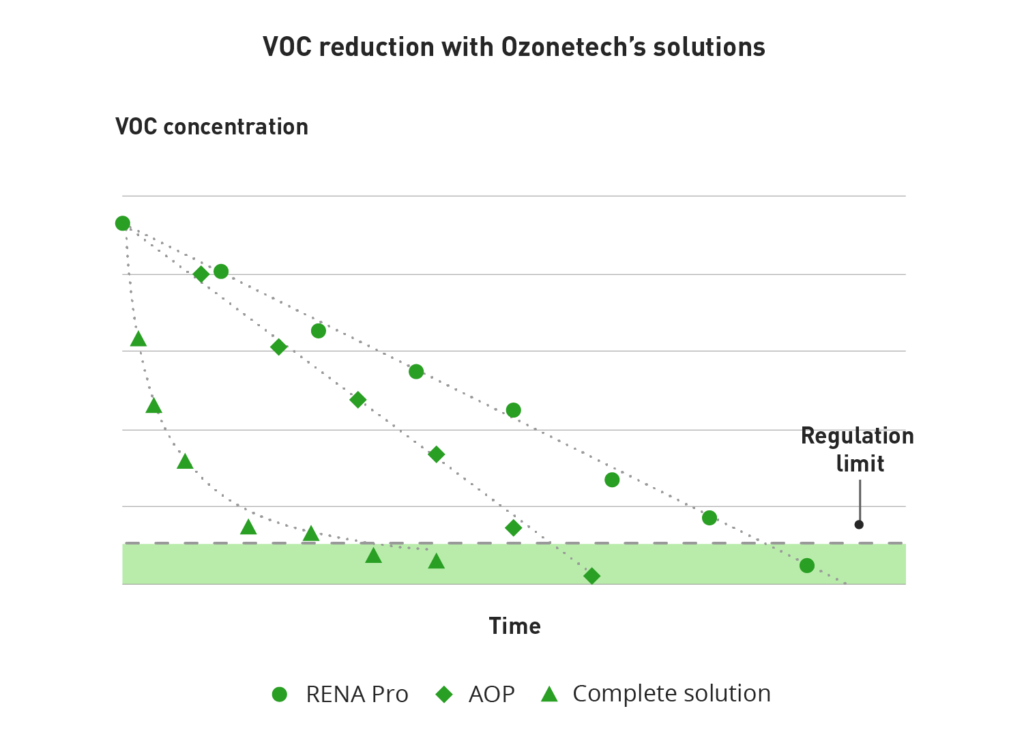
Even for high VOC concentration, we offer technologies capable of complying with strict environmental regulations in terms of VOC reduction.
Systems and solutions
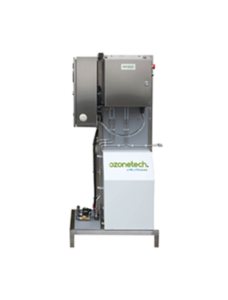 RENA Pro
RENA Pro
The RENA Pro solution offers a premium ozone treatment for the process stream. Ozone quickly reacts with the emitted VOC, oxidizing them without harmful byproducts. This results in a great VOC treatment, with an outlet concentration below the most stringent environmental limits. We always offer our RENA Pro solutions with a tailor-made design, specifically engineered for each case. We consider relevant inlet parameters such as air flow and VOC concentration, dosing the right amount of ozone based on the target we have to reach. Such a tailor-made solution results in great energy savings and high process efficiency, lowering the operational costs for the ozone treatment.
Read more about our RENA Pro solutions or download our brochure.
RENA Pro combined with UV systems
For particulartly heavy VOC loads or very stringent regulatory limits, we may combine the RENA Pro solution with our Saniray UV systems (external site) resulting in an AOP solution. The term AOP stands for Advanced Oxidation Processes and refers to a technology capable of producing a chemical species called hydroxyl radical. In our system, ozone is transformed in hydroxyl radicals once it get irradiated by the UV light. This chemical species is even more aggressive than ozone for removing VOC. The VOC treatment is then boosted by the UV reactor, resulting in more compact system having a high performance. Our UV systems uses only High-Performance UV lamps, for the most effective treatment in the most compact footprint.
Read more about our Saniray UV systems & solutions (external site)
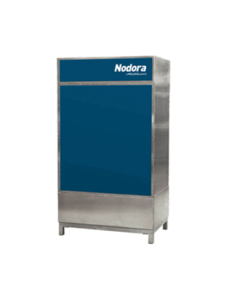 Combination of AOP stage and Nodora
Combination of AOP stage and Nodora
For ultimate performance in terms of VOC treatment, we recommend our complete solution, combining the AOP stage and the Nodora (external site) filters . The addition of Nodora to the previous solution offers a final polishing of the treated stream, resulting in VOC emissions close to zero. This stage is a catalytic mixed-bed filter composed by several tailor-made materials designed for maximizing the VOC treatment. The Nodora filters are used in the most demanding cases, when the space is limited but still a very effective VOC treatment is needed. In addition, the Nodora filters have a special design for minimizing the pressure drops, with great savings for the energy consumption and the operational costs.
Read more about our Nodora solutions (external site) or download our brochure.
VOC problems may be also related to odor problems. Read more about odor control.


